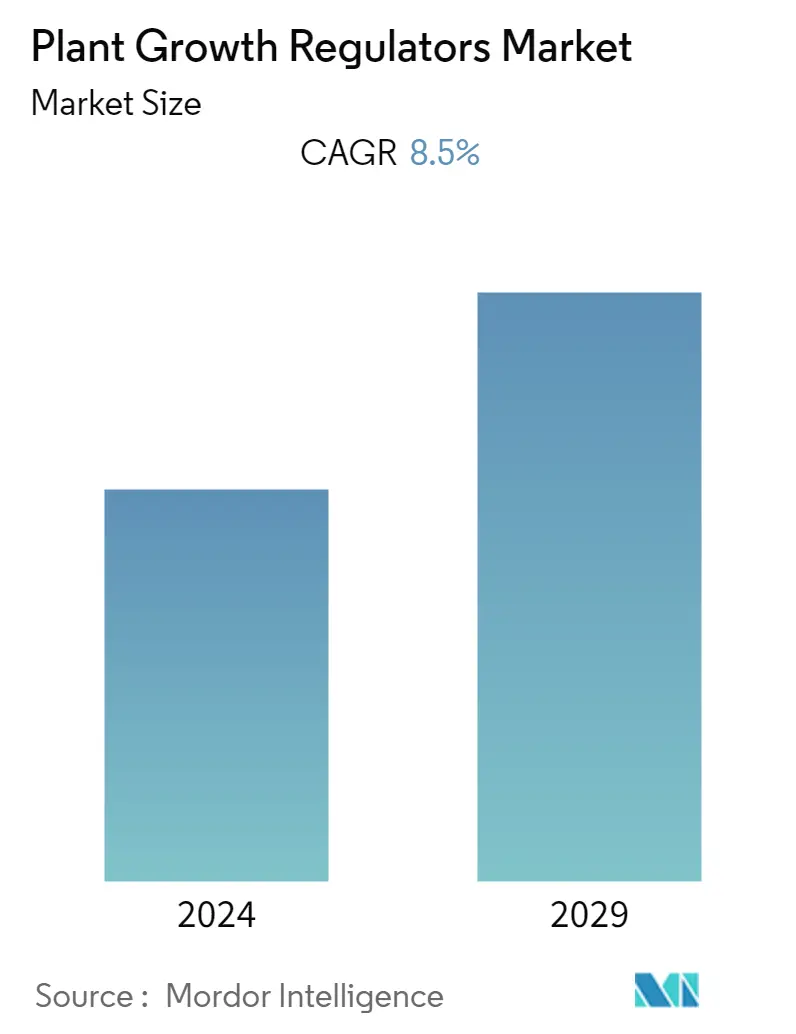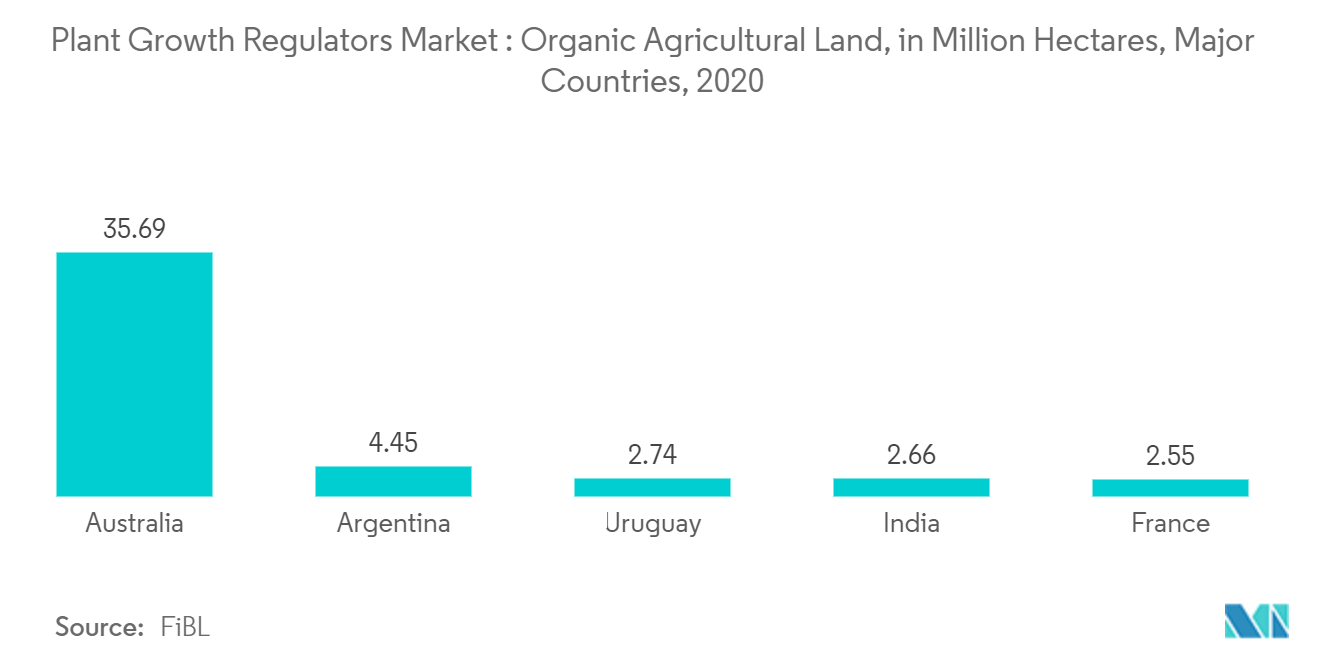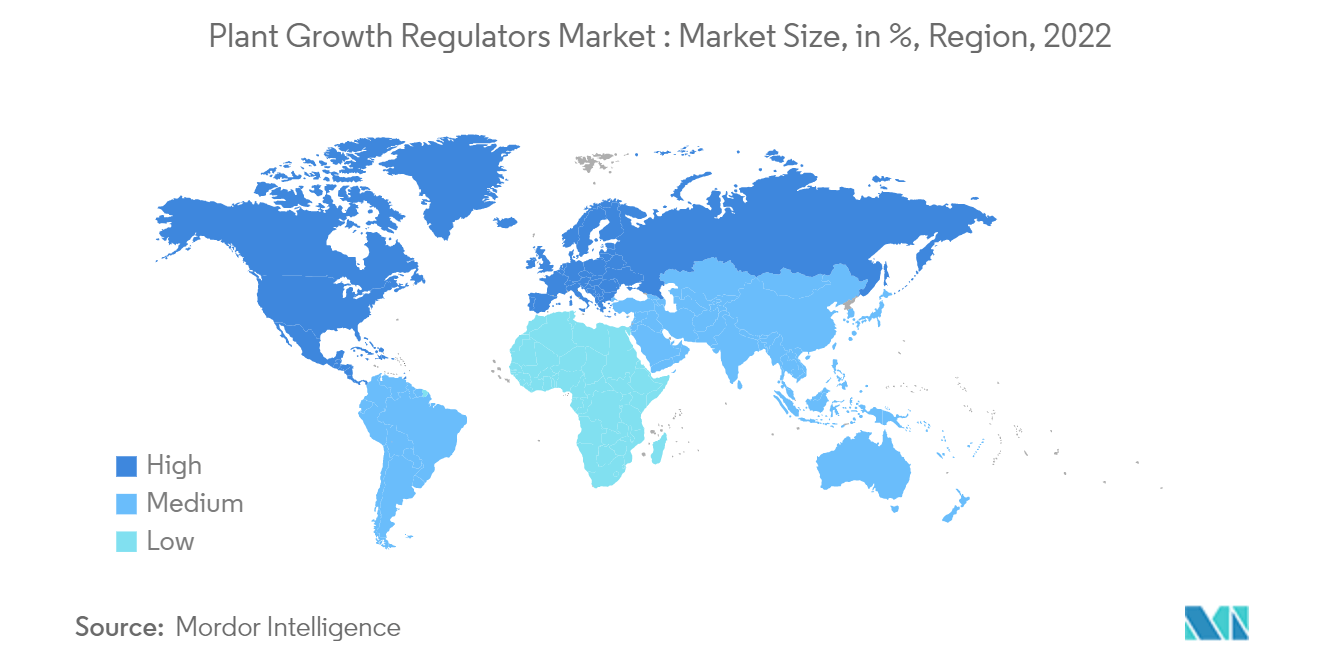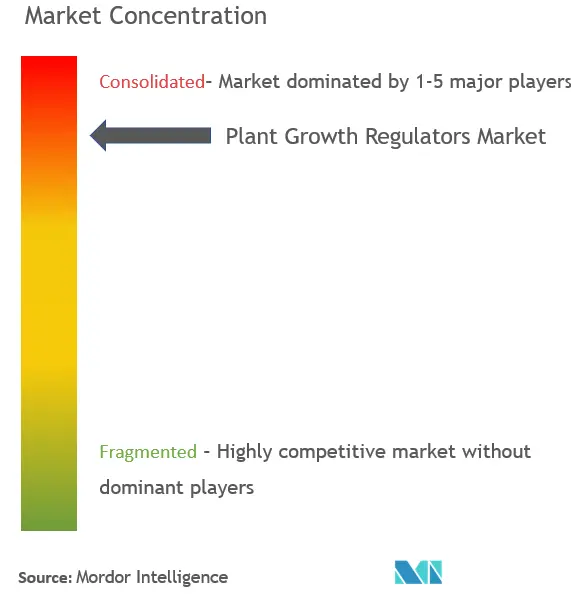Plant Growth Regulators Market Size

| Study Period | 2019 - 2029 |
| Base Year For Estimation | 2023 |
| CAGR | 8.50 % |
| Fastest Growing Market | Asia Pacific |
| Largest Market | Europe |
| Market Concentration | High |
Major Players
*Disclaimer: Major Players sorted in no particular order |
Plant Growth Regulators Market Analysis
The Plant Growth Regulators Market is poised to grow at a CAGR of 8.5% during the forecast period.
- Plant growth regulators (PGRs) are chemicals that act like phytohormones and affect the plant's physiological processes. There has been an increasing demand for fruits, and the application of plant growth regulators (PGRs) on fruits is continuously increasing to enhance crop yield. In Africa, plant growth regulators are highly used for vegetables, such as potatoes, tomatoes, and onions. Fruits are enhanced by the application of PGR, especially apples, pears, and peaches.
- Globally, cytokinins are witnessed to have high growth due to the increased production of fruits and commercial vegetables. Factors like increasing organic farming and the need for sustainable agriculture are driving the market. The market studied is anticipated to have a better growth rate in the future, as farmers are inclining towards the latest technology in the agricultural sector.
- Currently, the penetration of plant growth regulators products is observed to be relatively high in field crops, such as cotton, in Middle East & Africa. Such high adoption in the cotton crop is particularly attributed to the higher need for maintenance in the vegetative and reproductive growth balance in the cotton crop, as compared to other crops. Plant growth regulators are also used to increase the boll size, boll retention, harvest efficiency, as well as to reduce plant height and increase the canopy size in the cotton production.
- To maintain market competitiveness, many companies are engaged in new product development, innovation, and acquisition. For instance, Syngenta Canada registered Moddus, a new plant growth regulator that helps reduce lodging risk in wheat, barley, and oats. Moddus contains trinexapac-ethyl, an active component that has been used for years to control lodging in grain crops across the world.
Plant Growth Regulators Market Trends
Increasing Demand for Sustainable Agricultural Practices
The application of plant growth regulators may help increase the blossom rate, stimulate plant growth, and delay the onset of sprouting of root crops. Such positive results alter the plant nutrition and aid the commercial agribusinesses in increasing the quality and quantity of the crop yield.
Plant growth regulators (PGR) are recognized for promoting growth and development under optimal and stress conditions. Reducing the crop loss under the impact of these climatic variations is a great challenge and requires substantial reforming of crop improvement programs and agronomical practices. In such conditions, plant growth regulators (PGRs) are useful tools to combat these stresses and climate variation for sustainable crop production.
Among all the growth regulators, cytokinins are widely consumed and account for around 35% of the market share. Cytokinins are expected to continue as the fastest-growing segment as they enhance stress tolerance and stimulate protein synthesis. Auxin is the second-largest segment, and it is expected to grow due to the increasing demand for medicinal plants and growth in turf and landscaping. Cereals and oilseeds are the major consumers of plant growth regulators, followed by fruits and vegetables, accounting for around 75% of the market share.
According to the World of Organic Agriculture (FiBL) 2022 report stated that the share of the world's agricultural land that is organic was 1.6 percent in 2020. The highest organic share of total agricultural land, by region, was in Oceania with 9.7 percent, followed by Europe with 3.4 percent and Latin America with 1.4 percent. In the European Union, the organic share of the total agricultural land was 9.2 percent, and the other regions, the share is less than one percent. In 2020, the organic agricultural land increased in all continents. The highest absolute growth was in Latin America (19.9 percent), followed by Europe (3.7 percent) and Asia (7.6 percent), which will escalate to propel the growth of the sustainable agricultural pratices in the market.

Europe Dominates the Market
European countries promote sustainable agriculture, food security, and rural development. In the European Union, the European Commission has pledged itself to the Form to Fork Strategy, which is centered on organic farming. In this approach, 25% of the EU's agricultural land will be used for organic farming by 2030. Therefore, enhancing crop yield while achieving sustainability has become more crucial. Hence, the demand for plant growth regulators in Europe is considerably high due to the large-scale organic farming industry, where specific plant hormones such as cytokinin, auxins, and gibberellins are utilized in several farming methods.
National governments are expected to invest more in organic farming to make their food industries more resilient. Organic farming will also be encouraged as countries look to reduce pesticide usage and improve soil fertility. In May 2020, as part of the European Green Deal, the EU announced the target of reaching 25 percent of farmland organic by 2030. The EU's farm-to-fork strategy aims to improve food security in Europe. The strategy plans to reduce the environmental impact of the European food system by reducing chemical pesticide use by 50 percent, hazardous pesticide use by 50 percent, fertilizer use by 20 percent, and nutrient losses by 50 percent by 2030.
The huge demand is due to the increasing growth of organic farming and increasing indoor farming units like greenhouses and glasshouses. Vegetables and fruits are increasingly becoming the main users of plant growth regulators, thus driving the market. To cater to this growing demand, companies are introducing new products into the market. For instance, in 2020, BASF launched Attraxor in the United Kingdom. Attraxor is a new plant growth regulator (PGR) that features the powerful active prohexadione-calcium.

Plant Growth Regulators Industry Overview
The market is highly consolidated, with few players occupying the larger share globally. The major players in the market are BASF SE, Bayer Crop Science, Syngenta, UPL Ltd, and Corteva Agriscience. The market players are keen on launching new crop-targeted products, especially in the fruit and vegetable sectors. Investment in R&D of cheap, effective products is another strategy adopted by market leaders. Acquisitions and mergers are some of the main strategies adopted by the MNCs for effective penetration into the market.
Plant Growth Regulators Market Leaders
-
BASF SE
-
Bayer Crop Science
-
Corteva Agriscience
-
UPL Limited
-
Syngenta
*Disclaimer: Major Players sorted in no particular order

Plant Growth Regulators Market News
- June 2022: Valent Canada Inc. and Nufarm Agriculture Inc. have extended their distribution arrangement in Canada for additional five years. The Valent-Nufarm collaboration has been operating in Canada since 2011, supplying a broad range of plant growth regulators through Nufarm's established distribution channels.
- July 2021: Sumitomo Chemical received the US regulatory approval for the registration of its new plant growth regulator (PGR) AccedeTM (active ingredient 1-aminocyclopropane-1-carboxylic acid (ACC)). Accede is a fruit thinner categorized as a PGR developed by Sumitomo Chemical as one of the bio rationales in its A2020 pipeline.
- April 2020: BASF introduced a plant growth regulator named Attraxor for turf and other types of grasses in the United Kingdom. It contains Prohexadion(10%w/w) as the main ingredient.
Plant Growth Regulators Market Report - Table of Contents
1. INTRODUCTION
- 1.1 Study Assumptions and Market Defintion
- 1.2 Scope of the Study
2. RESEARCH METHODOLOGY
3. EXECUTIVE SUMMARY
4. MARKET DYNAMICS
- 4.1 Market Overview
- 4.2 Market Drivers
- 4.3 Market Restraints
-
4.4 Porter's Five Forces Analysis
- 4.4.1 Bargaining Power of Suppliers
- 4.4.2 Bargaining Power of Buyers/Consumers
- 4.4.3 Threat of New Entrants
- 4.4.4 Threat of Substitute Products
- 4.4.5 Intensity of Competitive Rivalry
5. MARKET SEGMENTATION
-
5.1 Type
- 5.1.1 Cytokinins
- 5.1.2 Auxins
- 5.1.3 Gibberlins
- 5.1.4 Other Types
-
5.2 Application
- 5.2.1 Crop-based
- 5.2.1.1 Grains and Cereals
- 5.2.1.2 Pulses and Oilseeds
- 5.2.1.3 Fruits and Vegetables
- 5.2.1.4 Turf and Ornamentals
- 5.2.1.5 Other Crops
- 5.2.2 Non-crop-based
- 5.2.2.1 Turf and Ornamental Grass
- 5.2.2.2 Other Applications
-
5.3 Geography
- 5.3.1 North America
- 5.3.1.1 United States
- 5.3.1.2 Canada
- 5.3.1.3 Mexico
- 5.3.1.4 Rest of North America
- 5.3.2 Europe
- 5.3.2.1 Spain
- 5.3.2.2 United Kingdom
- 5.3.2.3 France
- 5.3.2.4 Germany
- 5.3.2.5 Italy
- 5.3.2.6 Russia
- 5.3.2.7 Rest of Europe
- 5.3.3 Asia-Pacific
- 5.3.3.1 China
- 5.3.3.2 Japan
- 5.3.3.3 India
- 5.3.3.4 Thailand
- 5.3.3.5 Australia
- 5.3.3.6 Rest of Asia-Pacific
- 5.3.4 South America
- 5.3.4.1 Brazil
- 5.3.4.2 Argentina
- 5.3.4.3 Rest of South America
- 5.3.5 Africa
- 5.3.5.1 South Africa
- 5.3.5.2 Rest of Africa
6. COMPETITIVE LANDSCAPE
- 6.1 Most Adopted Competitor Strategies
- 6.2 Market Share Analysis
-
6.3 Company Profiles
- 6.3.1 BASF SE
- 6.3.2 Bayer Crop Science
- 6.3.3 Corteva Agriscience
- 6.3.4 Crop Care Australia Pty Ltd
- 6.3.5 Barclay Crop Protection
- 6.3.6 Sumitomo Chemical Australia Pty Ltd
- 6.3.7 NuFarm Ltd
- 6.3.8 Redox Industries Ltd
- 6.3.9 Xinyi (H.K.) Industrial Co. Ltd
- 6.3.10 Sichuan Guoguang Agrochemical Co. Ltd
- 6.3.11 Fine Americas Inc.
- 6.3.12 Chemtura AgroSolutions
- 6.3.13 Valent BioSciences Corporation
- 6.3.14 Hangzhou Tianlong Biotechnology Co. Ltd
- 6.3.15 Tri-DWARF Industrial Co. Ltd
- 6.3.16 WinField Solutions LLC
- *List Not Exhaustive
7. MARKET OPPORTUNITIES AND FUTURE TRENDS
** Subject To AvailablityPlant Growth Regulators Industry Segmentation
Plant growth regulators are chemical compounds other than nutrients that modify a plant's physiological processes. The Plant Growth Regulators Market is Segmented by Type (Cytokinins, Auxins, and Gibberellins), Application (Crop-based and Non-crop-based), and Geography (North America, Europe, Asia-Pacific, South America, and Africa). The report offers market size and forecast in terms of value (USD Million) and in terms of volume (Metric ton) for the above-mentioned segments.
| Type | Cytokinins | |
| Auxins | ||
| Gibberlins | ||
| Other Types | ||
| Application | Crop-based | Grains and Cereals |
| Pulses and Oilseeds | ||
| Fruits and Vegetables | ||
| Turf and Ornamentals | ||
| Other Crops | ||
| Application | Non-crop-based | Turf and Ornamental Grass |
| Other Applications | ||
| Geography | North America | United States |
| Canada | ||
| Mexico | ||
| Rest of North America | ||
| Geography | Europe | Spain |
| United Kingdom | ||
| France | ||
| Germany | ||
| Italy | ||
| Russia | ||
| Rest of Europe | ||
| Geography | Asia-Pacific | China |
| Japan | ||
| India | ||
| Thailand | ||
| Australia | ||
| Rest of Asia-Pacific | ||
| Geography | South America | Brazil |
| Argentina | ||
| Rest of South America | ||
| Geography | Africa | South Africa |
| Rest of Africa |
Plant Growth Regulators Market Research FAQs
What is the current Plant Growth Regulators Market size?
The Plant Growth Regulators Market is projected to register a CAGR of 8.5% during the forecast period (2024-2029)
Who are the key players in Plant Growth Regulators Market?
BASF SE, Bayer Crop Science, Corteva Agriscience, UPL Limited and Syngenta are the major companies operating in the Plant Growth Regulators Market.
Which is the fastest growing region in Plant Growth Regulators Market?
Asia Pacific is estimated to grow at the highest CAGR over the forecast period (2024-2029).
Which region has the biggest share in Plant Growth Regulators Market?
In 2024, the Europe accounts for the largest market share in Plant Growth Regulators Market.
What years does this Plant Growth Regulators Market cover?
The report covers the Plant Growth Regulators Market historical market size for years: 2019, 2020, 2021, 2022 and 2023. The report also forecasts the Plant Growth Regulators Market size for years: 2024, 2025, 2026, 2027, 2028 and 2029.
Plant Growth Regulators Industry Report
Statistics for the 2024 Plant Growth Regulators market share, size and revenue growth rate, created by Mordor Intelligence™ Industry Reports. Plant Growth Regulators analysis includes a market forecast outlook to 2029 and historical overview. Get a sample of this industry analysis as a free report PDF download.



